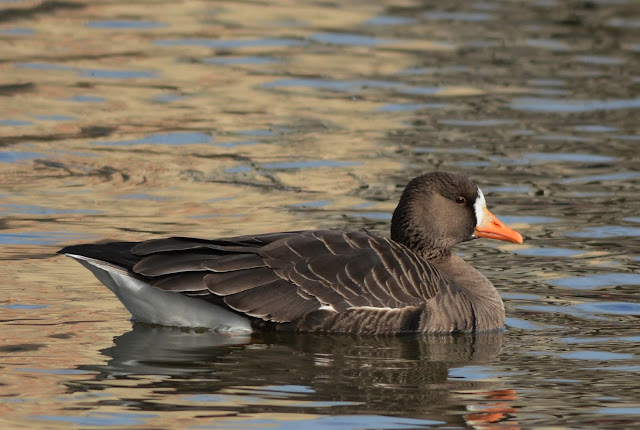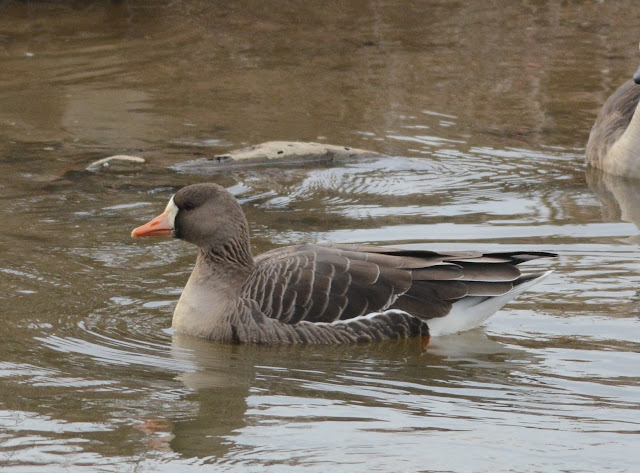Greater White-fronted Geese in the Mid-Atlantic - Part 2
Bird 6 - Lewes, Delaware, February 2017
This bird was only observed swimming so some features e.g. extent of black on underparts, could not be assessed. However it showed a noticeably orange-toned bill that has a shape consistent with flavirostris. The structure, relatively dark overall tones, dark head and a lack of contrast between the face and the broad black line bordering the white front, buff/pale brown fringing on the upperparts and narrow flank stripe are consistent with flavirostris. The extent of the white tail band and the white fringes on the outer edges of the tail feathers are at the well-marked end for flavirostris. Overall I can't see any features to rule out flavirostris.
"Bird" 7 - Bombay Hook, Delaware, February 2017
This group of 8 birds spent part of the year at Bombay Hook. I could not get very close views, but the distinct pale upperparts barring on most of the birds, fairly prominent white flank stripes, pinkish bills and distinct narrow black edge to the white front, contrasting with the face, indicate they are gambelli.
Bird 8 - Alexandria, Virginia, January 2015
The overall buffy-grey color to this bird, the fairly broad white tip and fringing on the tail, a bill that is distinctly pinker than the feet, a pale breast and a well contrasting dark border to the white front indicate this is a gambelli not a flavirostris. The bill on this bird was quite petite and overall it had a "cute" look to it. The head looked consistently rounded, not square and blocky as on many flavirostris. It is similar to albifrons although the bill is not the typical bright pink. This bird is also recorded in eBird as a flavirostris.
Bird 9 - Black Hill RP, Maryland, January 2016
I only saw this bird early in the day and at a distance. As can be seen from the photos below, it seemed to have a broad white flank stripe; in flight it showed relatively sparse black markings on the underside which do not extend past the end of the dark flank patches; and the bill seems to show a hint of an extended, parallel-edged teat-like tip. Although one can't be definitive given the quality of the photos, these suggest this was more likely a gambelli.
This bird was only observed swimming so some features e.g. extent of black on underparts, could not be assessed. However it showed a noticeably orange-toned bill that has a shape consistent with flavirostris. The structure, relatively dark overall tones, dark head and a lack of contrast between the face and the broad black line bordering the white front, buff/pale brown fringing on the upperparts and narrow flank stripe are consistent with flavirostris. The extent of the white tail band and the white fringes on the outer edges of the tail feathers are at the well-marked end for flavirostris. Overall I can't see any features to rule out flavirostris.
"Bird" 7 - Bombay Hook, Delaware, February 2017
This group of 8 birds spent part of the year at Bombay Hook. I could not get very close views, but the distinct pale upperparts barring on most of the birds, fairly prominent white flank stripes, pinkish bills and distinct narrow black edge to the white front, contrasting with the face, indicate they are gambelli.
Bird 8 - Alexandria, Virginia, January 2015
The overall buffy-grey color to this bird, the fairly broad white tip and fringing on the tail, a bill that is distinctly pinker than the feet, a pale breast and a well contrasting dark border to the white front indicate this is a gambelli not a flavirostris. The bill on this bird was quite petite and overall it had a "cute" look to it. The head looked consistently rounded, not square and blocky as on many flavirostris. It is similar to albifrons although the bill is not the typical bright pink. This bird is also recorded in eBird as a flavirostris.
Bird 9 - Black Hill RP, Maryland, January 2016
I only saw this bird early in the day and at a distance. As can be seen from the photos below, it seemed to have a broad white flank stripe; in flight it showed relatively sparse black markings on the underside which do not extend past the end of the dark flank patches; and the bill seems to show a hint of an extended, parallel-edged teat-like tip. Although one can't be definitive given the quality of the photos, these suggest this was more likely a gambelli.












Comments
Post a Comment